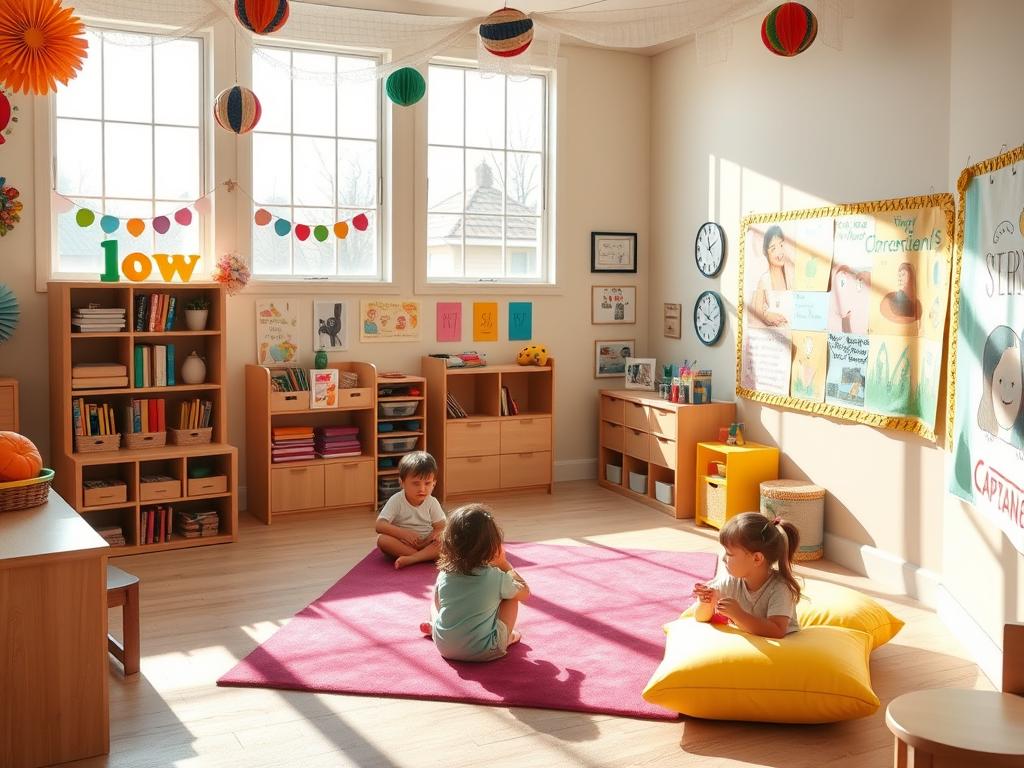As the summer sun starts to fade, a familiar buzz of excitement fills the air—it’s back-to-school time! For many children, this period can elicit a mix of joy, nervousness, and anticipation. Imagine a parent standing with their child at the school entrance, where vibrant posters and cheerful faces greet them. The parent whispers, “This is a fresh start, a place to learn and grow.” In that moment, they discuss how it’s normal to feel a bit anxious about new faces and classes—a universal truth for kids heading into unfamiliar territory.
How to Support Your Child at the Beginning of the New School Year is vital as kids transition, whether they’re entering school for the first time or just moving up a grade. A little preparation and forethought can lay a positive foundation, making the first weeks smoother for both children and parents. From establishing a daily routine to fostering communication about their feelings, each step serves as a building block in easing back into school routine. By tuning into their child’s emotions and setting up a supportive home environment, parents can champion their kids’ journeys toward academic success and emotional well-being.
Key Takeaways
- Starting school can be an emotionally charged experience for kids; preparation is key.
- Encouraging conversations about school can help alleviate anxiety.
- Establishing a consistent routine benefits students in easing back into school life.
- Bonding with teachers and peers is crucial for comfort in the classroom.
- Setting academic and social goals can pave the way for a successful year.
- Prioritizing self-care and a healthy balance of activities is essential for students’ well-being.
Create a Positive Back-to-School Mindset
Creating a positive mindset is essential for supporting child’s emotional well-being during the transition back to school. Open discussions about feelings regarding the new school year can provide a safe space for children to express their concerns and anxieties. It validates their emotions and creates opportunities for problem-solving strategies that enable them to manage their worries effectively.
Discuss Their Feelings About the New Year
Encouraging children to share their thoughts about starting a new school year promotes emotional intelligence. This practice can strengthen their coping mechanisms, making them more resilient. Discussing aspects like reunions with friends or new classes can help them focus on the excitement ahead instead of their fears. Providing specific feedback and using tools like fun self-esteem games can further help children articulate their emotions and experiences.
Encourage Enthusiasm for Learning
Fostering a positive mindset for school involves highlighting the joys and opportunities of learning. Parents can celebrate small achievements to build confidence and promote a growth mindset. Activities such as setting personal goals for academic success or exploring new subjects together create a joyful anticipation about learning. Consistently reminding children that mistakes are opportunities to learn enhances their resilience. The process of helping children adjust to school can be fun and engaging if approached with positivity and creative strategies.

| Strategy | Benefits | Implementation Tips |
|---|---|---|
| Open Discussions | Validates feelings, encourages problem-solving | Schedule regular times to talk about school |
| Celebrate Small Achievements | Builds confidence, promotes a growth mindset | Create a reward system for milestones |
| Interactive Learning Games | Boosts engagement and enthusiasm | Incorporate games like team activities or challenges |
Organize a Back-to-School Supplies Checklist
Preparing for a new school year involves effective school supplies organization. A comprehensive back to school checklist ensures that no essential items are overlooked. Each grade has different requirements, and knowing these can help families budget accordingly. In the last back-to-school shopping season, U.S. families spent a staggering $41.5 billion on school-related purchases, averaging around $890 per household.
Essential Items for Different Grades
Each grade typically has a specific set of items needed, with average costs varying widely:
| Grade Level | Average Cost |
|---|---|
| Kindergarten | $188.50 |
| Grades 1-3 | $213 |
| Grades 4-5 | $194 |
| Middle School | $320 |
| High School | $330 |
| College | $718.50 |
Being mindful of these costs can aid in planning your family’s budget for school supplies. Essential items commonly include notebooks, folders, pens, and calculators. Engaging in parental involvement in school prep can make this process smoother.
Involve Your Child in the Process
Encouraging your child to participate in the shopping process fosters a sense of ownership and accountability for their education. Together, you can create a checklist that also serves as a bonding experience. As you gather supplies like lunchboxes, hand sanitizer, and other necessities, discuss how each item is used in their school life. Taking this approach not only helps ensure that vital items are included but also builds excitement for the upcoming year.
For additional tips on planning, you may find more resources on packing effectively for family activities.

Establish a Consistent Routine
Creating a consistent routine is essential for supporting children as they transition back to school. Establishing a routine for school helps reduce anxiety and provides a sense of stability. Parents can implement strategies to create sleep schedules for children that prepare them for the upcoming academic year.
Set Regular Bedtimes and Wake Times
Adjusting children’s sleep schedules gradually is beneficial. Ideally, children should aim for a wake-up time of 6:30 AM once school starts. To achieve this, implement a plan to adjust their current wake-up time, which is typically around 8:00 AM. A suggestion is to shift their wake time by 30 minutes earlier each week for four weeks. This gradual change allows children to adapt smoothly without causing significant disruption. Regular bedtimes contribute to better concentration and energy for school activities.

Schedule Homework and Study Sessions
Effective homework schedule creation is vital for academic success. Establishing a designated time for homework each day fosters responsibility among children. Make clear expectations around when and where homework should be completed. Creating an organized space for studying, utilizing color-coded folders or binders, can also enhance efficiency. Engage with the child’s teacher early on to understand the homework policy and ensure children are equipped to manage their responsibilities effectively.
Incorporating a family calendar can further reinforce the routine, keeping everyone on track. Recognizing milestones such as completing homework or following bedtime routines can be encouraged through positive reinforcement techniques like sticker charts. These strategies not only support children in managing their schedules but also promote a more organized and successful start to the school year.
| Strategy | Time Frame | Benefits |
|---|---|---|
| Gradual Wake-Up Adjustment | 4 weeks (30 mins earlier/week) | Better adaptation to school schedule |
| Designated Homework Time | Daily | Encourages responsibility and routine |
| Family Calendar | Year-round | Increases organization and accountability |
| Positive Reinforcement | Ongoing | Motivates children to adhere to schedules |
Visit the School Together
Participating in school visit preparation is a fantastic way to help children transition into a new academic year. Visiting the school with your child before classes begin allows them to become comfortable in their new surroundings. This experience can significantly alleviate any anxiety they may feel about starting at a new school. Meeting teachers helps establish early connections that provide reassurance and support during this period of adjustment.
Meet the Teacher and Staff
Attending orientation sessions or meet-and-greet events enables parents to engage with teachers and staff. Establishing a rapport with educators is essential for effective parent-teacher communication. Many children feel calmer when they recognize familiar faces, which can ease their transition into a new environment. This early connection also ensures that parents can voice any concerns or expectations regarding their child’s needs, especially as teachers often work with students adjusting to new schools or districts.
Familiarize Your Child with the Campus
During this visit, accompany your child as they explore the school grounds. Encourage them to observe important areas such as the cafeteria, restrooms, and the playground. Familiarity with these locations reduces anxiety, making the first day less daunting. Practicing the route to school, whether on foot or by car, provides further security and confidence. Involving your child in the visit enables them to feel ownership over their school journey, creating a sense of empowerment during this significant change.
Help Them Set Goals for the Year
Setting goals for kids, especially at the start of a new school year, can significantly enhance their focus and motivation. Clear, attainable goals empower children to take greater ownership of their academic journey and social interactions. Engaging them in this process allows them to envision their successes and approach obstacles with a positive mindset.
Academic and Social Goals
Establishing both academic and social objectives is vital for a well-rounded development. Students can enhance their learning experiences by setting specific, measurable goals. For instance, a child may aim to read a certain number of books each month or practice math skills each week. Socially, they might set a goal of befriending someone new by introducing themselves at least once a week. Following this structured goal setting can lead to significant improvements, aligning perfectly with academic success strategies.
Use Positive Reinforcement Techniques
Incorporating positive reinforcement for children can further propel their motivation. Recognizing and celebrating milestones, whether small or large, creates an uplifting environment that encourages continual progress. Families can brainstorm actionable plans together, ensuring that goals remain suitable for the child’s grade level. Keeping track of their achievements can build their self-esteem and readiness for future challenges. For practical insights on communication techniques to support your child, check out this effective guide designed for parents.
Monitor Their Academic Progress
Monitoring academic progress plays a pivotal role in ensuring your child’s success during the school year. Engaging in this process allows parents to identify areas where their children may require additional assistance or resources. Checking homework and assignments regularly encourages accountability, giving students the motivation they need to stay on top of their studies.
Check Homework and Assignments Regularly
Establishing a consistent routine for checking homework promotes a sense of responsibility in children. Regular engagement helps parents stay informed about their child’s workload and any potential challenges. Create a checklist or a table to keep track of homework and important assignments:
| Day | Homework/Assignments | Status |
|---|---|---|
| Monday | Math worksheet | Completed |
| Tuesday | Reading assignment | In Progress |
| Wednesday | Science project | Not Started |
| Thursday | History essay | Completed |
| Friday | Art project | In Progress |
Communicate with Teachers Frequently
Effective communication with teachers is essential for understanding your child’s academic performance. Keeping an open line of communication allows parents to ask questions about their child’s progress and any areas needing improvement. Schools like Saint John’s Prep encourage parents to reach out via email, fostering a collaborative approach that supports academic success. Participating in parent-teacher conferences can further strengthen this bond, facilitating ongoing dialogue about your child’s journey through the school year. Explore ways to enhance these discussions by visiting 4 ways to support your child with.
Build a Supportive Home Environment
Creating a supportive home environment is fundamental to enhancing your child’s academic performance and overall well-being. A dedicated study space for children can dramatically minimize distractions, fostering concentration and productivity. Tailoring the study area to your child’s age—whether it’s cozy corners for preschoolers or more structured setups for high school students—can promote effective learning and instill a sense of responsibility towards their studies.
Create a Dedicated Study Space
Consistently organizing a clutter-free and appealing study area is imperative for children of all ages. This dedicated space not only encourages focus but also establishes a routine that contributes to a sense of security and predictability. For instance, designating specific homework times for elementary-aged children, like 4:00 PM to 5:00 PM, helps create a rhythm that can enhance their productivity and reduce stress.
Encourage Healthy Habits and Activities
In addition to a dedicated study space, parents should promote encouraging healthy habits, such as nutritious meals, regular exercise, and proper sleep schedules. Instilling these routines—like aiming for consistent wake-up times at 7:00 AM for younger children or a 10:00 PM bedtime for teens—contributes to a balanced lifestyle conducive to learning. By fostering open communication and nurturing emotional well-being, parents can ensure their children thrive throughout the school year in a supportive home environment.











